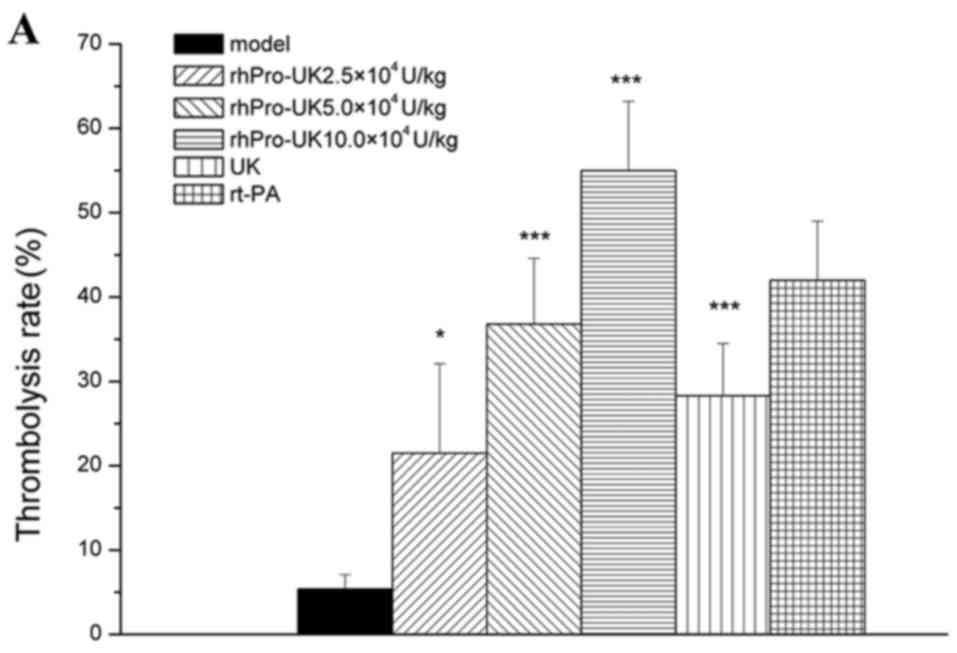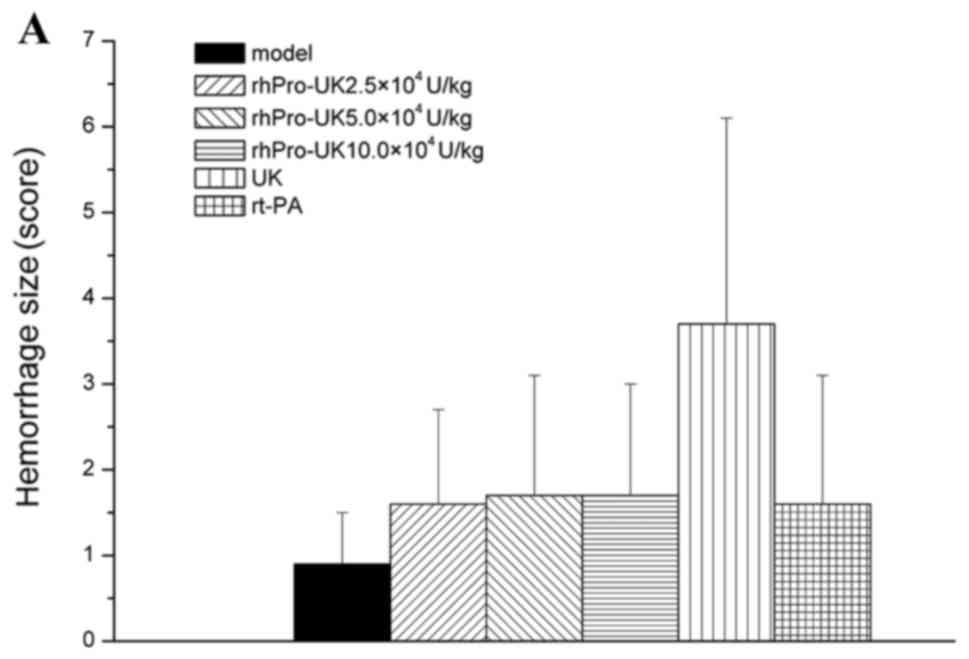Effect of recombinant human prourokinase on thrombolysis in a rabbit model of thromboembolic stroke
- Authors:
- Published online on: November 3, 2017 https://doi.org/10.3892/br.2017.1013
- Pages: 77-84
Metrics: Total
Views: 0 (Spandidos Publications: | PMC Statistics: )
Total PDF Downloads: 0 (Spandidos Publications: | PMC Statistics: )
Abstract
The aim of the present study was to investigate the efficacy of recombinant human prourokinase (rhPro-UK) on thromboembolic stroke in rabbits. A total of 210 rabbits were used in experiments. The 180 thromboembolic stroke rabbits were divided into three therapeutic time windows with six groups in each time window (n=10). The model group was administered saline, the reagent groups were administered rhPro-UK (2.5x, 5x and 10x104 U/kg), and the positive control groups were administered 5x104 urokinase (UK) U/kg and 4.5 mg/kg recombinant human tissue plasminogen activator via intravenous infusion at 3, 4.5 and 6 h after embolism. The remaining 30 rats (that had not undergone occlusion by autologous blood clots) served as a sham group and were administered saline. The radioactive intensity was detected using a medical gamma counter before and after the administration of the drug for 15, 30, 45, 60, 75, 90, 105 and 120 min. At 24 h after treatment, the brain samples were coronally sliced into 5 mm sections and hemorrhage was estimated used a semiquantitative method by counting the number of section faces with hemorrhaging. The plasma was collected for prothrombin time, activated partial thromboplastin time, fibrinogen and thrombin time tests using a solidification method with a blood coagulation factor analyzer. In addition, α2-antiplasmin (α2-AP) was evaluated using ELISA methods using a RT-6100 microplate reader. At the 3 h time point, the thrombolysis rate of rhPro-UK(2.5x, 5x and 10x104 U/kg) was 21.5% (P<0.05), 36.8% (P<0.001) and 55.0% (P<0.001), respectively together with patency rates of 10% (P>0.05), 40% (P<0.05) and 70% (P<0.001). Furthermore, α2-AP levels were reduced by 5.3% (P>0.05), 5.3% (P>0.05) and 18.1% (P<0.05). At the 4.5 h time point, the thrombolysis rate was 18.8% (P<0.05), 29.9% (P<0.01) and 49.0% (P<0.001) together with patency rates of 10% (P>0.05), 30% (P<0.05) and 50% (P<0.01), and α2-AP levels were reduced by 2.4% (P>0.05), 6.5% (P>0.05) and 17.8% (P<0.05). At the 6 h time point, the thrombolysis rate was 14.7% (P<0.05), 24.1%(P<0.01) and 35.7% (P<0.001) together with patency rates of 20% (P>0.05), 30% (P<0.05) and 40% (P<0.01), and α2-AP levels were reduced by 5.7% (P>0.05), 12.7% (P>0.05) and 22.2% (P<0.01). No significant differences (P>0.05) were identified between rhPro-UK (2.5x, 5x and 10x104 U/kg) and the model group regarding hemorrhage type, size and blood coagulation factors at the different time points. Thus, rhPro-UK promoted thrombolysis and recanalization (patency rate), with reduced risk of cerebral hemorrhage, and thus exerted protective effects on cerebral ischemia rabbits.












